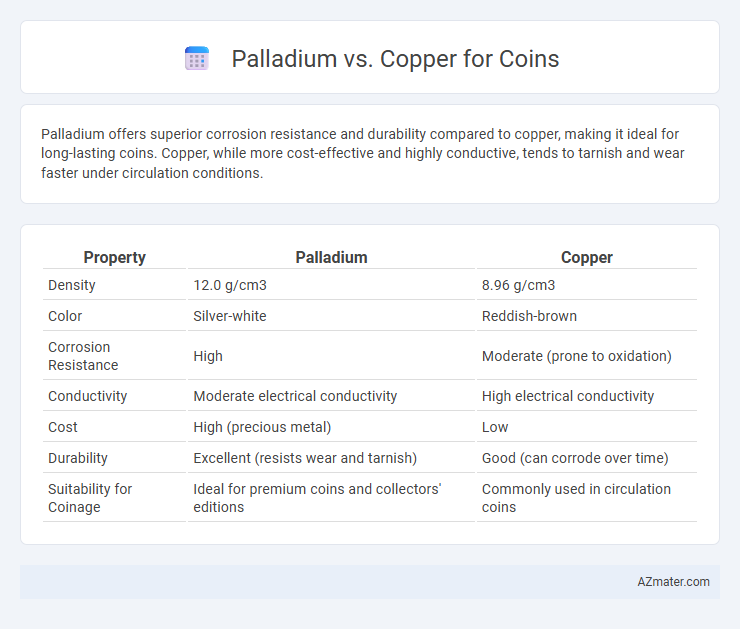Palladium offers superior corrosion resistance and durability compared to copper, making it ideal for long-lasting coins. Copper, while more cost-effective and highly conductive, tends to tarnish and wear faster under circulation conditions.
Table of Comparison
| Property | Palladium | Copper |
|---|---|---|
| Density | 12.0 g/cm3 | 8.96 g/cm3 |
| Color | Silver-white | Reddish-brown |
| Corrosion Resistance | High | Moderate (prone to oxidation) |
| Conductivity | Moderate electrical conductivity | High electrical conductivity |
| Cost | High (precious metal) | Low |
| Durability | Excellent (resists wear and tarnish) | Good (can corrode over time) |
| Suitability for Coinage | Ideal for premium coins and collectors' editions | Commonly used in circulation coins |
Introduction to Palladium and Copper in Coinage
Palladium and copper are metals used in coinage for their distinct properties and value. Palladium, a rare and lustrous platinum-group metal, offers corrosion resistance and a silvery-white appearance, making it ideal for high-value or commemorative coins. Copper, a more abundant base metal, is prized for its durability, affordability, and reddish hue, commonly used in lower denomination coins and as an alloy component to improve strength.
Historical Use of Palladium and Copper Coins
Copper has been a foundational metal in coinage for millennia, prized for its durability, affordability, and natural abundance, with historical coins such as ancient Roman sestertii and medieval pennies primarily composed of copper or copper alloys. Palladium, a rare and lustrous metal discovered in the 19th century, has been less commonly used in coinage but gained prominence in limited modern commemorative and investment coins due to its resistance to tarnish and distinctive silvery-white appearance. The historical use of copper in coins reflects its widespread availability and economic suitability, whereas palladium's usage remains niche and specialized, often linked to its status as a precious metal within the platinum group.
Physical Properties of Palladium vs Copper
Palladium exhibits a silvery-white metallic appearance with high corrosion resistance and a density of approximately 12.0 g/cm3, making it significantly heavier than copper, which has a reddish-brown hue and a density of 8.96 g/cm3. Palladium's melting point is around 1,554 degC, substantially higher than copper's 1,085 degC, contributing to greater thermal stability in coins. The hardness of palladium on the Mohs scale ranges from 4.75 to 5.25, compared to copper's 3.0, indicating superior scratch resistance and durability for coinage applications.
Rarity and Availability of Each Metal
Palladium is significantly rarer than copper, with annual global production around 200 metric tons compared to copper's 20 million metric tons, making palladium a scarce metal for coinage. Copper is widely available, mined in large quantities worldwide, and extensively used in coins due to its affordability and durability. The limited supply of palladium drives higher market prices and exclusivity, positioning it as a premium material compared to the abundant and economical copper.
Durability and Resistance to Wear
Palladium coins exhibit superior durability and resistance to wear due to palladium's hardness and corrosion-resistant properties, making them ideal for long-term circulation and investment. Copper, while more affordable and widely used in coinage, is softer and prone to tarnishing and surface wear over time. The enhanced wear resistance of palladium ensures preserved details and extended lifespan compared to copper coins.
Aesthetic Differences: Color and Finish
Palladium coins exhibit a naturally bright, silvery-white color that resists tarnishing, maintaining a lustrous and clean finish over time. Copper coins feature a warm, reddish-brown hue that develops a distinctive greenish patina called verdigris as they age, adding character but altering surface clarity. The color contrast between palladium's sleek, modern appearance and copper's classic, rustic tones highlights the aesthetic choice for collectors and investors.
Investment Value: Palladium vs Copper Coins
Palladium coins hold significantly higher investment value compared to copper coins due to palladium's rarity, industrial demand, and intrinsic worth as a precious metal. Copper coins, while affordable and historically significant, have lower market value and limited appreciation potential in investment portfolios. Investors favor palladium coins for their liquidity, price stability, and status as a hedge against inflation and economic uncertainty.
Industrial and Collectible Demand
Palladium coins attract strong industrial demand due to palladium's critical role in catalytic converters for automotive emissions control, driving sustained price growth and investor interest. Copper coins maintain significant collectible demand because copper's historical use in currency and its affordability make copper coins popular among numismatists and entry-level collectors. While palladium coins are prized for their rarity and industrial relevance, copper coins benefit from widespread accessibility and rich numismatic heritage.
Environmental and Ethical Considerations
Palladium mining has a smaller environmental footprint than copper extraction, requiring less land disruption and producing fewer greenhouse gas emissions. Copper mining often leads to significant habitat destruction, water pollution, and higher energy consumption, raising ethical concerns about ecosystem damage. Palladium's rarity and more sustainable sourcing options contribute to its growing preference in coin production due to ethical and environmental benefits.
Conclusion: Choosing Between Palladium and Copper for Coins
Choosing between palladium and copper for coins hinges on factors such as durability, cost, and market value. Palladium offers superior resistance to tarnish and corrosion, making it ideal for high-value collector coins, while copper provides affordability and excellent conductivity, suitable for everyday circulation coins. Evaluating the intended use, budget, and long-term investment potential is essential to determine the optimal metal choice for coin production.

Infographic: Palladium vs Copper for Coin
 azmater.com
azmater.com